Weekly Reports from Jordan
Choose Year: or Choose week
June 28-July 4, 2008
Merlè Otto-Steenbergen, Canadian University College
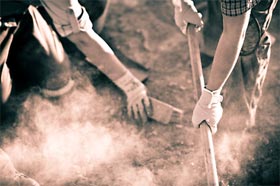 After one full week at the dig, most of us have come to appreciate the words, "eat dirt," in a whole new light. Dirt is our life for the next five weeks. It gets into every exposed orifice and perhaps even into the blood. What draws people to this archaeological adventure? Not everyone here is an archaeological expert. Some first-timers are students of archaeology, here for the experience and the credits, but others, like me, are fulfilling a desire to satisfy their curiosity about history and the workings of an actual "dig" in the Middle
After one full week at the dig, most of us have come to appreciate the words, "eat dirt," in a whole new light. Dirt is our life for the next five weeks. It gets into every exposed orifice and perhaps even into the blood. What draws people to this archaeological adventure? Not everyone here is an archaeological expert. Some first-timers are students of archaeology, here for the experience and the credits, but others, like me, are fulfilling a desire to satisfy their curiosity about history and the workings of an actual "dig" in the Middle 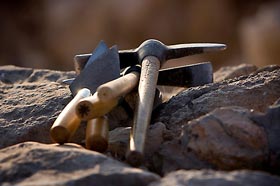 East. There are veterans of the dig who keep coming back season after season because the excitement of uncovering the past creates an overwhelming urge to return; there is also a sort of proprietary pride about each field and each square.
East. There are veterans of the dig who keep coming back season after season because the excitement of uncovering the past creates an overwhelming urge to return; there is also a sort of proprietary pride about each field and each square.
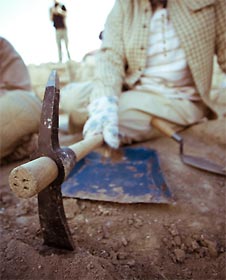 Our first real work at Tall al-`Umayri came on Friday, June 27. That was our introduction to the sheer physicality of working a dig. We learned how to properly wield a small pick and trowel. There is a technique! Those of us in Field M had a chance to see how the work actually begins from the top down: surveying the field, marking out each square, creating a balk in between the squares (archaeology lingo). Things in the manual that were a mystery are now beginning to make sense. (They told us that would happen!)
Our first real work at Tall al-`Umayri came on Friday, June 27. That was our introduction to the sheer physicality of working a dig. We learned how to properly wield a small pick and trowel. There is a technique! Those of us in Field M had a chance to see how the work actually begins from the top down: surveying the field, marking out each square, creating a balk in between the squares (archaeology lingo). Things in the manual that were a mystery are now beginning to make sense. (They told us that would happen!)
On June 29, a tour was scheduled to acquaint us with some of the sights in Amman. Amman is a city built on seven hills, the magnificence of which most people say surpasses the seven hills of Rome. It is an awesome sight to ride down into the Suq (the marketplace) and then look up at the Citadel towers above you. We stopped first at the Roman Theater, a magnificently preserved structure from the second century A.D.. Some of our group climbed to the highest seats in order to test the acoustics. Several people recited 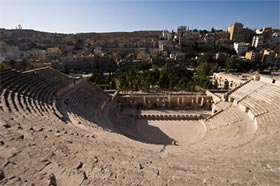 from Shakespeare.
from Shakespeare.
Teagan Johnson recited from Tarzan! Back to the buses and on to the Citadel where we saw the Temple of Hercules, the museum of the Department of Antiquities, the partial remains of an early Byzantine Church and the Umayyad Palace. So much history and culture compressed into one space. If a picture is worth a thousand words, there will be millions of words returning to homes across North America and Europe.
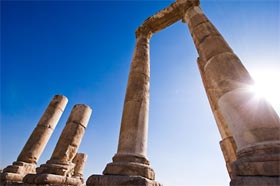 Our daily and weekly routines have been established. If the call of the muezzin does not rouse you at 3:45 a.m (and at 4 a.m.), the morning bell at 4:15 should do the trick. If that doesn't work, your roommates will usually oblige. For roosters, the schedule is great. For night-owls, it's a little more challenging. First breakfast is served buffet style in the cafeteria in the Amman Training Centre (our home) at 4:30 am. and buses load around 5 - 5:10 a.m. It takes three buses and several cars to move all the people to the tell-about a fifteen-minute drive. This week, two
Our daily and weekly routines have been established. If the call of the muezzin does not rouse you at 3:45 a.m (and at 4 a.m.), the morning bell at 4:15 should do the trick. If that doesn't work, your roommates will usually oblige. For roosters, the schedule is great. For night-owls, it's a little more challenging. First breakfast is served buffet style in the cafeteria in the Amman Training Centre (our home) at 4:30 am. and buses load around 5 - 5:10 a.m. It takes three buses and several cars to move all the people to the tell-about a fifteen-minute drive. This week, two 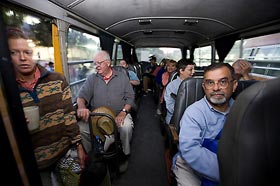 bus loads were jolted awake as the buses hit sleeping policemen, or mattabs (speed bumps) which seem to abound in certain areas. Fortunately, although Kaitlyn Kramer kissed the ceiling of the bus, there were no compressed vertebrae - only flying potsherds. Successive trips were much tamer.
bus loads were jolted awake as the buses hit sleeping policemen, or mattabs (speed bumps) which seem to abound in certain areas. Fortunately, although Kaitlyn Kramer kissed the ceiling of the bus, there were no compressed vertebrae - only flying potsherds. Successive trips were much tamer.
Walking up the tell at first light is a thrill. Photographs have already been taken of each square before the light can distort the images; workers, the magnificent goat hair tent and the sifts at the top of the tell are silhouetted against the lightening sky. There is the orderly grab for guffahs (shallow baskets made from recycled tires ), brushes, and dustpans from the tent at the base of the tell just before the ascent. These are part of the array of tools which include trowels (mastoreen) and small picks with which to probe the earth.
There is a seriousness to the work but it is punctuated by the banter between workers in individual squares and adjacent squares, interspersed with Arabic-English exchanges as two cultures grapple for understanding in a common pursuit. This is not without challenges. Two handy phrases that we almost immediately learned were "Yella" (quickly) and "Dir balak" (be careful). There was a great chorus line at the top sifts with Jennifer Ayles, Dana Waters, Eveleyna Laurie, and Elinor Matthews singing renditions of the Coconut Song and whatever other lyrics popped into their heads. In fact, spontaneous song plays a large part in keeping up the spirits of the diggers and sifters. My favorite is the commercial song, "Like a Rock"... only now we can substitute the Arabic word for rock - hajar!
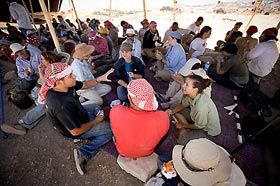 Everyone works in their squares until second breakfast, which usually arrives around 9:30 a.m. Then we all gather in the goat hair tent to enjoy some shade and falafel or shwarma sandwiches (meat or falafels, along with pickles, tomatoes and cucumbers wrapped in a kind of Jordanian tortilla). This is followed by the longstanding traditional watermelon slaughter presided over by Kent Bramlet, who slices the melon on the high place of sacrifice. You will see a row of people along the top of the tell consuming watermelon as the juice drips down chins and makes tracks in their dirt masks;
Everyone works in their squares until second breakfast, which usually arrives around 9:30 a.m. Then we all gather in the goat hair tent to enjoy some shade and falafel or shwarma sandwiches (meat or falafels, along with pickles, tomatoes and cucumbers wrapped in a kind of Jordanian tortilla). This is followed by the longstanding traditional watermelon slaughter presided over by Kent Bramlet, who slices the melon on the high place of sacrifice. You will see a row of people along the top of the tell consuming watermelon as the juice drips down chins and makes tracks in their dirt masks; 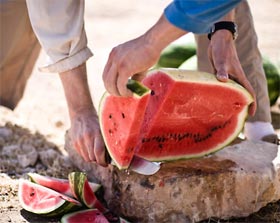 the rinds are aimed at a particular rock below and probably consumed later by wandering herds of goats. Sometimes there is even hot, sweet tea served in little glasses which is made by the Jordanian government representatives over an open fire.
the rinds are aimed at a particular rock below and probably consumed later by wandering herds of goats. Sometimes there is even hot, sweet tea served in little glasses which is made by the Jordanian government representatives over an open fire.
What happens when nature calls during the seven hours at the tell? There is a marvelous burlap-enshrouded one-person biffy which serves us well. Workers call out to ensure that no one is surprised, and everything then proceeds in an orderly fashion.
After second breakfast, work at the tell continues until 12:30 when workers descend to the 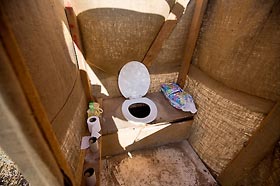 waiting buses after each square has been swept free of footprints, and pottery pails containing all the exciting "finds" (pottery sherds, bones, flints, and special objects) have been gathered. Sometimes there are "finds" other than pottery. Jennifer Ayles was working industriously in her square, Field M, 7K34 (without gloves) when she encountered a scorpion with an egg sac. After the "monster" was captured, news spread quickly and Jimmy Arsenault thought he would motivate the creature with his trowel. The creature "lunged" at Jimmy (as he tells it, and he managed
waiting buses after each square has been swept free of footprints, and pottery pails containing all the exciting "finds" (pottery sherds, bones, flints, and special objects) have been gathered. Sometimes there are "finds" other than pottery. Jennifer Ayles was working industriously in her square, Field M, 7K34 (without gloves) when she encountered a scorpion with an egg sac. After the "monster" was captured, news spread quickly and Jimmy Arsenault thought he would motivate the creature with his trowel. The creature "lunged" at Jimmy (as he tells it, and he managed 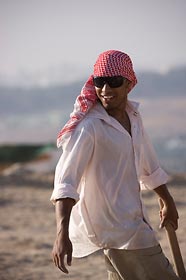 to surprise Field Supervisor, Aren LaBianca, who almost took a trip over the balk into Field H! A little excitement like this just adds to the fun.
to surprise Field Supervisor, Aren LaBianca, who almost took a trip over the balk into Field H! A little excitement like this just adds to the fun.
Just a word about a special worker in Field M: fourteen-year-old Aboud (this is the short, pronounceable version of his name), son of Romul, a representative from the Jordanian Department of Antiquities has joined Square 7K34 and is a talented English-Arabic translator whose services are often required. He also swings a mean pick axe and enjoys the nicknames, "Dig-Dig," or "Dig-Sift," an indication of his preferred activities. He also was challenged to compose a song after learning the word, "tedious." The young composer came up with the "Tedium Song," or "Te Deum," when appropriate.
After the morning dig, the buses drop the hot, tired workers, rimmed with dirt, at the ATC just in time to deposit pottery pails, bone bags and objects before lunch at 1 p.m. Pottery pails are filled with water and the pottery left to soak before being washed. 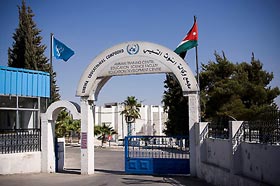 Denise Herr oversees this process and guides the uninitiated in the paperwork of pottery. (If Larry Herr is the King of Pottery Reading, Denise Herr is the Queen. You want to record everything correctly in order to avoid the dreaded sticky note from Denise.)
Denise Herr oversees this process and guides the uninitiated in the paperwork of pottery. (If Larry Herr is the King of Pottery Reading, Denise Herr is the Queen. You want to record everything correctly in order to avoid the dreaded sticky note from Denise.)
Lunch is a time when the "clean" (those who have managed to shower) and the "unclean" (those who have not) sit down amicably together. This is a time when "finds" are celebrated, special announcements are made, and other special celebrations may occur. Birthdays are celebrated with a chorus of Happy Birthday and ice cream.
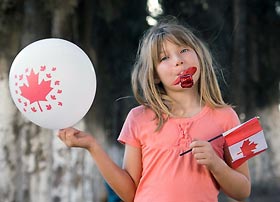 On July 1, Canada Day was celebrated in style at lunch time. The cook, Mohammad, made a special cake covered with fruit, and the Canadian contingent all stood to sing "O Canada." Lynne Fulton from Mount Royal College had managed to bring stickers, tattoos, flags, and noise makers to continue the celebration at supper time (6 p.m.)
On July 1, Canada Day was celebrated in style at lunch time. The cook, Mohammad, made a special cake covered with fruit, and the Canadian contingent all stood to sing "O Canada." Lynne Fulton from Mount Royal College had managed to bring stickers, tattoos, flags, and noise makers to continue the celebration at supper time (6 p.m.)
Dr. Julie Cormack, the rock specialist from Calgary, Alberta (one of many returning experts) just missed the celebration, arriving in the wee hours of July 2. Welcome back, Dr. Cormack!
American Independence Day was also celebrated with the national anthem sung in chorus, followed by a solo rendition from Faith Stevens. Hot dogs (Jordanian style) and ice cream with chocolate sauce were on the lunch menu for July 4.
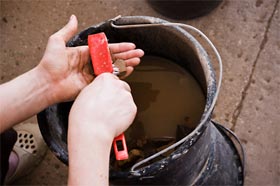 After lunch, there is "quiet time" from 2-4 p.m. Some people prefer to get a head start on pottery washing. Each square has to wash the pottery they have collected from the dig, and then set it to dry for the next day's reading.
After lunch, there is "quiet time" from 2-4 p.m. Some people prefer to get a head start on pottery washing. Each square has to wash the pottery they have collected from the dig, and then set it to dry for the next day's reading.
Pottery is "read" by Larry Herr after being laid out on tables according to field and square. The "reading" indicates the time period and the type of vessel. All pieces collected are counted and recorded, but only the diagnostic pieces are kept. Diagnostic shards are rims, bases, handles, and painted bits 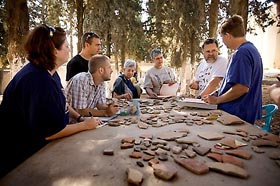 which more clearly isolate time and type. Objects are also "read," drawn by artists, and catalogued. Rocks and bones are treated in a similar way. Washing and reading may take right up to supper time at 6 p.m. The way the pottery is laid out may invite accusations of OCD, but as Jennifer Ayles retorts, "It should be CDO!" (She's not at all obsessive about alphabetical order.)
which more clearly isolate time and type. Objects are also "read," drawn by artists, and catalogued. Rocks and bones are treated in a similar way. Washing and reading may take right up to supper time at 6 p.m. The way the pottery is laid out may invite accusations of OCD, but as Jennifer Ayles retorts, "It should be CDO!" (She's not at all obsessive about alphabetical order.)
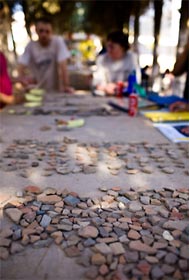 Following supper each day, there might be a few minutes to spend shooting hoops or playing "horse." This is where you will probably find Stephanie and Garrick Herr and assorted friends when Garrick is not busy fixing broken sifts, or other tools for the dig. Stephanie says "Hi, Mom!" and I am sure this is echoed by many others to their own moms. If you're quick, you might catch Kasey Brandt doing an amazing hand stand or another acrobatic antic near the court (or on any of the tours!)
Following supper each day, there might be a few minutes to spend shooting hoops or playing "horse." This is where you will probably find Stephanie and Garrick Herr and assorted friends when Garrick is not busy fixing broken sifts, or other tools for the dig. Stephanie says "Hi, Mom!" and I am sure this is echoed by many others to their own moms. If you're quick, you might catch Kasey Brandt doing an amazing hand stand or another acrobatic antic near the court (or on any of the tours!)
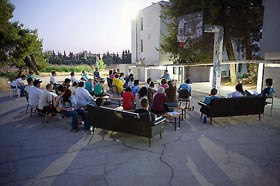 At 7 p.m., there is usually a guest speaker or some lecture which lasts until about 8:30 and then it's lights out at 9 p.m. because 4 a.m. comes far too fast.
At 7 p.m., there is usually a guest speaker or some lecture which lasts until about 8:30 and then it's lights out at 9 p.m. because 4 a.m. comes far too fast.
The weekly evening schedule is as follows:
Monday - Guest lectures
Tuesday/Thursday - MPP lectures or Town Hall meetings
Wednesday - Movie night (The Scarlet Pimpernel this week)
Friday - Free night
Saturday and Sunday - usually reserved for tours.
Sunday is also laundry day here. If you want to put something into the laundry, you must deposit it by the laundry doors by 7 a.m. and if you're lucky it will reappear in a laundered state by supper time along with hundreds of other articles all piled in heaps on several tables in the cafeteria. Sometimes it takes days for the heaps to disappear and for clothing to be found.
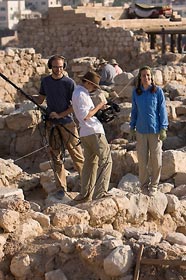 Camera crews (still and video) have been busy running around the tell documenting procedures and recording every exciting find in the field. Marc and Sharon Ullom and David Sherwin were kept busy while they were here, and Jonathan Betz and Jason Daub continue to keep busy recording finds and documenting field supervisor observations.
Camera crews (still and video) have been busy running around the tell documenting procedures and recording every exciting find in the field. Marc and Sharon Ullom and David Sherwin were kept busy while they were here, and Jonathan Betz and Jason Daub continue to keep busy recording finds and documenting field supervisor observations.
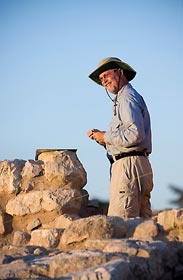 Should anyone need a band-aid, some ibuprofen, or immodium, (or anything else related to personal health and wellbeing) there is a great medical team: Dr. Gary Huffaker and his wife, Suha (also a nurse), and Dig Nurse, Carolyn Waldron.
Should anyone need a band-aid, some ibuprofen, or immodium, (or anything else related to personal health and wellbeing) there is a great medical team: Dr. Gary Huffaker and his wife, Suha (also a nurse), and Dig Nurse, Carolyn Waldron.
They dispense everything with loving care.
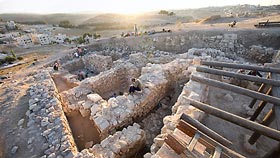 A moment of sheer pleasure ensued when Alice Holinger shared a container of lemon sherbet with Denise Herr, Carolyn Waldron, Dana Waters and Merlè Otto-Steenbergen. Sitting in the cool of the evening and spooning out this treat along with pleasant conversation was indeed a delight. These delights are not isolated. A community has been forged out of all the diverse ages and backgrounds and is governed by acts of kindness. If you don't have it, someone can supply it. If you need
A moment of sheer pleasure ensued when Alice Holinger shared a container of lemon sherbet with Denise Herr, Carolyn Waldron, Dana Waters and Merlè Otto-Steenbergen. Sitting in the cool of the evening and spooning out this treat along with pleasant conversation was indeed a delight. These delights are not isolated. A community has been forged out of all the diverse ages and backgrounds and is governed by acts of kindness. If you don't have it, someone can supply it. If you need 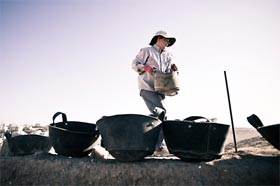 help, someone is there to help. The old and the young. The new and the veterans. So it begins.
help, someone is there to help. The old and the young. The new and the veterans. So it begins.
[ Photos courtesy David Sherwin, Sharon Prest and Marc Ullom. ]